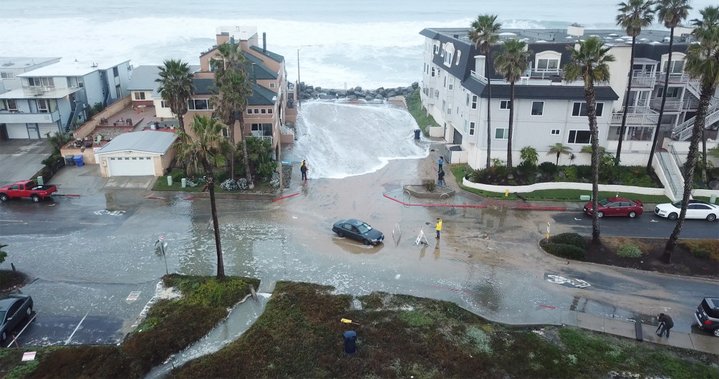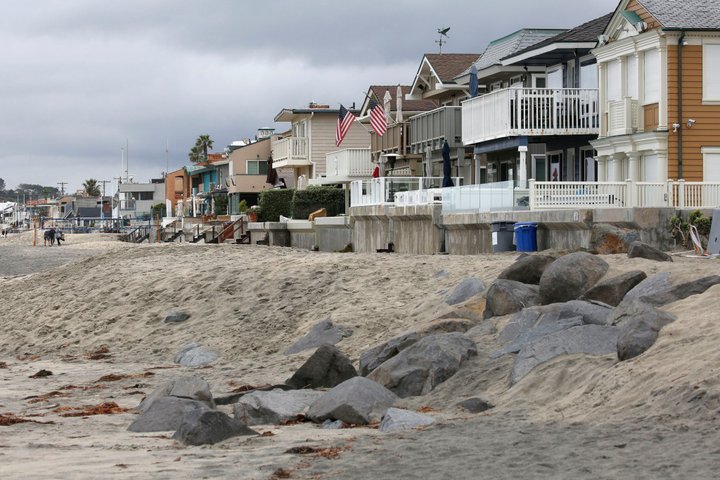
The aftermath of an ocean surge in Imperial Beach, California. Rising seas boost tides and imperil the city’s coastline. Photo via Scripps Institution of Oceanography, UC San Diego
###
The view from high up in Del Mar’s 17th Street lifeguard station is a visit-California poster: a sweeping curve of sand, dramatic coastal bluffs, a welcoming sea. What scientists see, though, is somewhat more sobering: the Pacific Ocean as seething menace, a marine battering ram born of climate change that will inexorably claim more and more land and whatever sits upon it.
With rising seas now posing a greater threat to California’s economy than wildfires or severe earthquakes, state authorities are cautioning those who live along some of the Golden State’s famous beaches to do what they’re loath to do: retreat. Turn their backs to the sea and move homes, businesses, schools and critical infrastructure out of harm’s way.
The ocean could rise two to ten feet by 2100, imperiling $150 billion in property, according to state estimates, and erasing two-thirds of California’s beaches. But even in the long history of battles at the beach, pitting the regulatory power of the California Coastal Commission against local governments and homeowners, managing people away from the water is proving especially difficult along most of the state’s shores.
“Very tense,” according to the commission’s executive director, Jack Ainsworth.
Here’s how it’s playing out. Cities and towns that hug the ocean, in what the state refers to as the “coastal zone,” must submit development projects and other long-term plans to the Coastal Commission for approval. The agency has asked that, as part of that process, local officials plan for the inevitability of sea rise and consider how to relocate vulnerable structures to safer ground. The commission has provided more than $8 million in taxpayer money to coastal towns to help fund the complex planning.
Among the possibilities is managed retreat, a purposeful, planned relocation of people and infrastructure away from the shoreline and the risk of rising seas. The commission’s statewide guidance asks that coastal cities consider how to phase in such a policy, but it stops short of requiring them to do it. And most haven’t.
At first, discussions between the commission and local authorities went fairly smoothly. Some communities understood the risk and welcomed advice, even adopting managed retreat as an option in early versions of their plans.
But then, for many local residents the words “managed retreat’’ came to stand in for two more dire words: “eminent domain,” government taking private property. Officials repeatedly tried to make clear that there is no policy to forcibly take homes. But the mistaken impression took hold, and it’s proven nearly impossible to put the genie back in the bottle.

Sand-and-rock berms form a barrier along beachfront homes in Del Mar, California. Photo by Peggy Peattie for CalMatters
In public meetings across California, homeowners, developers and real estate groups began to pelt local officials with questions: Is the state going to take my home? What about property values? How can I be sure I’ll be able to get insurance?
What the state saw as a prudent, forward-thinking approach to an admittedly slow-moving disaster begat a full-on coastal revolt. Under pressure from constituents, towns that had included managed retreat in their plans tore up the documents and called a time out. In some cities, the controversy hijacked the entire coastal planning process and adoption of other, noncontroversial aspects of coastal planning has languished.
“Things were going fine with local plans and residents were mostly receptive to managed retreat as an option. Then they blew up,” Ainsworth said. Some Coastal Commission meetings were consumed by the topic.
“There was a lot of misinformation and fear,” he said. “Some of it was understandable. But there was also a pretty well organized campaign that just took over the narrative.”
An armored coast can mean smaller beaches, something the Coastal Commission doesn’t want to see. But it’s a tradeoff many homeowners are willing to make.
To attorney Larry Salzman, director of litigation for the conservative property-rights group Pacific Legal Foundation, the commission has been heavy-handed, favoring relocation over armoring the coast with sea walls, jettys and other barriers intended to protect homes.
An armored coast can mean smaller beaches, something the Coastal Commission doesn’t want to see. But it’s a tradeoff many homeowners are willing to make, at least for now. Groups that oppose managed retreat say they should be allowed to stay where they are and allowed to put up whatever defenses they can to protect their residences.
The commission is “putting pressure on local governments to adopt a permitting standard that makes it impossible for homeowners to protect their property in the face of advancing hazards,” said Salzman, who has sued the Coastal Commission on behalf of homeowners. “Coastal property owners have a right to safeguard their property as long as they don’t impinge on others.”
In the face of such political blowback, some officials are shirking their responsibility to plan for their community’s future, said Coastal Commission member Sara Aminzadeh.
“There’s managed retreat, and there’s unmanaged retreat,” she said, arguing that it’s cheaper and more efficient to plan for catastrophe than to respond once it arrives. “It’s a great disappointment to me to see local leaders take the easy way out. In my heart I feel that leaders of all levels of government need to step up. It’s their responsibility.”
Many of the charming homes that front the beach in the upscale San Diego County enclave of Del Mar — population 4,400 — are raised on berms and crouched behind piles of large boulders and concrete sea walls. The Coastal Commission says the residences are nevertheless at risk of being taken by the sea in coming decades, and the city ought to have a plan to move them back.

Del Mar City Councilman David Druker. Photo by Peggy Peattie for CalMatters
But city officials see it differently, saying the row of oceanfront homes is itself a bulwark for the neighborhoods behind it. “If those sea walls come down, and the homes moved, then all the houses behind them that are only two to three feet above sea level will be inundated from the ocean,” said David Druker, a member of the Del Mar City Council.
The notion of backing off the coast is anathema in a tourist town that attracts more than a million annual visitors to wide beaches, nautical-themed boutiques and seaside restaurants. While its government is at an impasse with the Coastal Commission on long-term planning, the advancing sea is not.
And as in many coastal cities, the rising ocean makes managing flooding from other sources — winter storms, a swollen river — more difficult. On a recent rainy day, the parking lot around the famed Del Mar racetrack and the adjacent county fairgrounds was a vast inland lake.
Officials are considering building a berm there to prevent future flooding. Druker pointed out a nearby bridge that needs to be raised several feet to escape higher tides, and the rail corridor along the coast is due for a $5 billion realignment inland.
Druker said city officials accept the science of climate change and know the sea is rising. What he wants is more flexibility from the state, more research on timelines and a better understanding of what it means to relocate families and businesses: What is the legal mechanism for it? Who pays? What are the anticipated long-term effects on the community?
The notion of backing off the coast is anathema to Del Mar residents. The tourist town attracts more than a million annual visitors.
State officials say they want to help and are considering ways to accelerate research and funding for responses to climate change.
Gov. Gavin Newsom has proposed a $4.75 billion climate-resilience bond measure for the fall ballot as one possible funding source. Another is legislation that would establish a loan fund to allow coastal cities to relocate critical infrastructure and pay willing sellers to move. An additional proposal would codify the Coastal Commission’s authority to regulate issues related to rising seas and provide additional money for coastal planning.
Those proposals are in limbo at the moment, as the state’s response to the coronavirus threat has blown the budget and has swept many plans off the table.
As Del Mar residents aired their concerns at city meetings and listening sessions, the message became clear: Say no to retreat.
“Those beachfront residences are anywhere from $8 million to $40 million-dollar homes,” said Csilla Crouch, a local real estate agent. She said her home, two blocks from the beach, would eventually be washed away if any of the oceanfront houses were to be removed.
Until the city council made it clear recently that it was not considering planned retreat, Crouch said, potential buyers continued to express concerns about the policy.
“If a buyer is thinking about a multimillion-dollar home and learns that there is a threat of eminent domain, do you think he’s going to buy? Probably not,” she said.
Unlike tony Del Mar, the working-class town of Imperial Beach sits across a polluted river from the Mexican city of Tijuana. In this southernmost settlement on California’s 1,000-mile coastline, nearly 30% of the children live in poverty.
Flooding is already common in this community bordered by water on three sides — by the Pacific, the Tijuana River estuary and the San Diego Bay — all causing problems for the city. Imperial Beach is moving infrastructure such as sewer lines away from the shore and pondering how to protect a vulnerable elementary school. So-called king tides, which are dangerously high tides that are made worse by the rising sea, can flood the town with three feet of seawater and drown the main street, Seacoast Drive.
Local officials commissioned a study that concluded as much as 40% of the city could flood much more often as the ocean continues to rise. With that in mind, the city’s coastal plan had entertained the possibility of moving some of the town’s 28,000 residents away from its nearly flat shoreline.
But with each public meeting on the issue, residents responded with anger and fear. Sessions convened to discuss such coastal planning issues as development and building regulations were taken over by bickering and shouting about the scourge of managed retreat.
“We couldn’t discuss anything else,” said City Councilman Ed Spriggs. “There’s been nothing like it.”
The conflict has driven Mayor Serge Dedina, a lifelong surfer who directs a local environmental group, away from his previous support for retreat. The city had imagined moving itself three blocks inland, but the public uproar and financial calculations caused him to rethink.
Dedina complains that less wealthy cities, like his, are not equipped to pay for wide-ranging retrofits with more pressing issues such as infrastructure upgrades and cleanup of the sewage-polluted river.
“The reality is, there’s no funding for us to do anything, and we have no intention of taking anyone’s home away,” he said. “The Coastal Commission is spending all this time on the managed retreat conflict and nothing else is getting done.”
Coastal plans codify a number of key local rules, including zoning standards, building permitting and even vacation-home rental controls. Some cities have found it difficult to come to agreement on any of those issues while managed retreat remains on the table.
“So for us the question is: Why did we even do this (planning)?” Dedina said. “It’s an absolute waste of our time because instead of figuring out how to protect our coast, we got in a battle over managed retreat, and that is not helping our city at all.”
Brenda Clark was walking on the beach recently with her yellow lab, Cooper. She’s lived in a shorefront condo since 2010, tucked behind a nine-foot seawall. Clark said she’s followed the public debate but doesn’t think moving back from the water should be a priority for Imperial Beach.
“I have lived at the beach my whole life,” she said, and experience has taught her that nature will nearly always defeat attempts to impede it. “I am concerned about property values, of course. But if you buy a house by the ocean, figure it out.”
Not everyone is so sanguine.

Imperial Beach resident Brenda Clark on the sand with her dog Cooper. Photo by Peggy Peattie for CalMatters
Jennifer Savage, California policy manager for the Surfrider Foundation, which advocates for beach preservation, said local officials should be mindful not to sacrifice public beaches in order to protect vacation homes.
She likens the crowding of homes and businesses along the swelling sea to building subdivisions in high-wildfire-risk areas.
“We have developed in such a way that we cannot maintain the status quo with the changes in the natural world,” Savage said. “We can’t get to solutions because people have this very emotional reaction to managed retreat.
“They dig in and don’t face the facts,” she said. “The reality is: The water is coming.”
###
CALmatters.org is a nonprofit, nonpartisan media venture explaining California policies and politics.
CLICK TO MANAGE